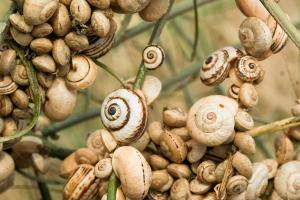The following NewScientist.com article was written by Fred Pearce and posted on June 8, 2015 with the title “Snail’s Demise Suggests Sixth Mass Extinction Is Underway”:
The meek may, as the Bible says, inherit the Earth. But the spineless are going extinct. While vertebrate species like mammals and birds are mostly surviving the human-dominated epoch of Anthropocene better than expected, invertebrate species are disappearing in droves. Some 7 per cent of non-marine animals may already be gone, according to a new assessment.
Conservationists have estimated that up to 100 species are disappearing from the planet every day because of human activity – a biological catastrophe amounting to a sixth mass extinction, the biggest since the disappearance of the dinosaurs. But the evidence of actual extinctions has been thin. Only around 800 species have been recorded as extinct so far, out of the 1.9 million species we have named.
Now Claire Regnier of the National Museum of Natural History in Paris, and colleagues, say this is because few researchers are tracking invertebrate extinctions, which account for some 99 per cent of species diversity. They have investigated databases, museum collections and expert assessments to estimate losses in land snails – one group of invertebrates with relatively good records. They conclude that around a tenth of the 200 known species have probably disappeared. (Journal reference: PNAS, DOI: 10.1073/pnas.1502350112.)
Because there are many endemic snails on small islands where extinction is more likely, land snails may not be typical of other invertebrates. But allowing for this, they think we have probably already lost 7 per cent of land animal species. That means an estimated 130,000 previously recorded non-marine animals have disappeared from the Earth since we described and classified them.
Other analysts welcomed the study. “This is an important paper,” says Julian Caley of the Australian Institute of Marine Sciences in Townsville, Queensland. It suggests that other invertebrate taxa are likely to have been experiencing extinction on higher levels than we know about, he adds. Ben Collen of University College London says the same approach could produce quick and informative results for other invertebrate taxa, too.
But, while the estimated percentage losses are alarming, they don’t answer the continuing conundrum of how many unnamed and unknown species the planet has – species that may disappear before we even know they exist. Estimates in recent years have been as high as 100 million, although that figure seems unlikely.
After a detailed study of insects, researchers at Griffith University in Brisbane, Australia, this week put the number of insect species on the Earth at between 2.6 and 7.8 million, many millions less than once thought. And in March, a world study of marine species cut the known list from 418,000 to 228,000, after eliminating massive duplication. One sea snail turned out to have 113 different scientific names.



